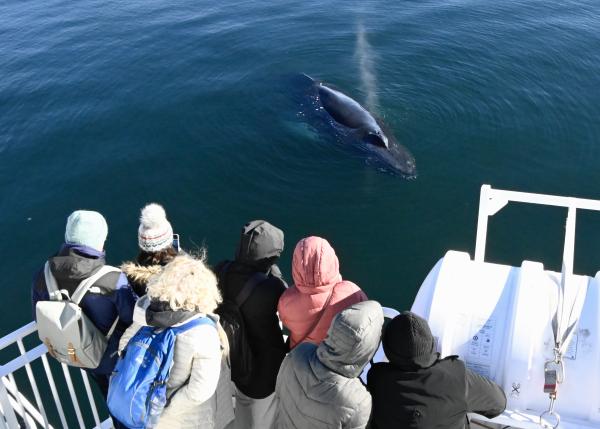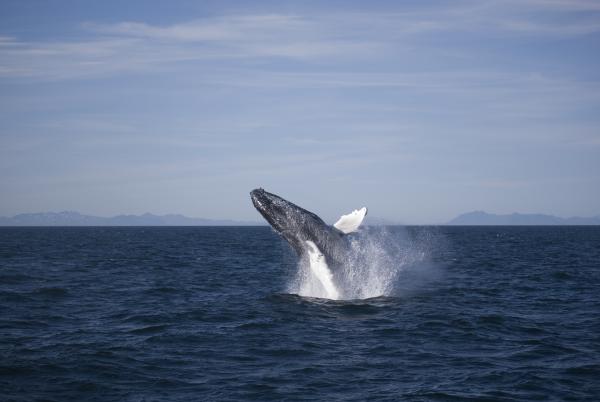Is whale watching in Iceland seasonal?
In general, summer is our busiest and most successful time to see whales or dolphins and, as we run on average more than 500 tours during that time, we have a great insight in the variability of the three main species. Also, with boats being more numerous during the summer season, finding the place where the cetaceans are is more likely as more area can be covered. Minkes are the predominant species followed by white-beaked dolphins and humpback whales.
During winter, it is not uncommon to see superpods (counted by hundreds!) of dolphins swimming across our bay, socialising with their calves or interacting with vessels by bow-riding. Winter time might be challenging, especially for weather-related reasons, but humpback whales like to highlight their presence in Icelandic waters, watched by avid whale watchers and scientists alike. The latter have discovered an interesting behaviour: a good amount of the humpbacks remain in the cold waters of the North Atlantic and practise a very unique whale-behaviour: they sing songs! This behaviour was believed to be performed only in the breeding grounds during the mating season, giving us a good example of the complexity of these animals.
But not all years are alike, we have inter-annual cycles too. Some years are better than others, factors afore mentioned might result in bigger/lower abundance of cetaceans in Faxaflói. It is worthy to highlight how in the years 2015-2016 (when Eldey, our biggest boat, joined the fleet and we could sail few more miles further into the bay) the abundance of humpbacks rocketed while minkes plummeted. This might suggest a strong competition for resources, in which humpbacks due to their size could displace smaller cetaceans from the foraging areas. However, our records show that winter months are the best to see orcas, with the notorious exception of June. This pattern seems to response to herring stocks, in which Icelandic orcas are specialised.
When is the best time of year to see whales in Iceland?
Surprisingly, such a simple question is not so easy to answer. It all relies on food availability at our shores and there are many factors that might influence where and when whales can find it.
Generally speaking, Iceland is considered as a feeding ground for cetaceans. Meaning that it's more likely to see the “big” whales during the summer months as they are massively coming to feed over fish stocks all around the island. The Irminger current moves clock-wise around Iceland distributing warm water in coastal areas, but it meets the east Greenland current in its way, cooling it down. When two masses with different temperatures meet, exciting things happen and it creates a great combination for fish to be born, spread and reproduce.
The whales that we usually see in Faxaflói are minke whales and humpback whales as well as white-beaked dolphins. They mainly feed over schooling fish such as sandeel, capelin or herring. These species are dynamic move, just like the whales. They are after food and during the summer time their presence increases due to another important factor in the marine ecosystems: plankton. Billions of tiny plant organisms appear in the Icelandic coastal waters during the warms months. Light availability (daylight of 24h) boost the primary production; phytoplankton and zooplankton emerge massively and they feed the entire trophic-chain from the tiny sandeels to the massive blue whales in an endless cycle of life.
What is the best time of day to see whales in Iceland?
Tides are one of the greatest powers of the oceans, moving millions of tons of water between ebbs and floods every 12 hours. Such movements affect the distribution of whales in their foraging areas, as the water masses (and organisms within) are carried away. Thanks to our research programme, we are able to track and record the sightings we have during our tours. We write down not only the species, but also number, location, date and time in an app that facilitates in-field data capture for conservation management.
Our results from last years show that there isn't a clear pattern to predict which time of the day is the best to see whales. Most of the sightings are clustered between an area where there are two major depressions. This indicates that cetaceans are probably gathering where they can find food, and according to our records they don’t mind morning, afternoon or evening as these areas overlap.
Are whales predictable or is it all based on luck?
If weather conditions, oceanic currents, location, food availability, tides and experience of the crew all combine together, we can have a great experience and enjoy these majestic animals surrounded by beautiful nature. After all, it's about being in the right place at the right time!
Elding operates all-year round which give us the opportunity to witness wildlife through different seasons. Thanks to this, we are able to collect invaluable data regarding the seasonality of the species in Faxaflói. The likelihood to see one or another species relies on an intricate web of several factors. The same way that food availability, weather conditions, oceanic currents or the North Atlantic oscillation influence the presence/absence of cetaceans in Faxaflói, their ecology, behaviour, seasonal movements and/or migrations contribute to increase/reduce the chances we have to see them at a specific time of the year.
A good combination of knowledge and experience has given us a better understanding of the marine ecosystem in Faxaflói, so we know what to expect during the year. However, we deal with wild animals which means that at the end of the day is entirely up to them. The blue whales seen in October 2011-2012, humpback whales during winter 2018-2019 in Viðey or even the rare northern right whale spotted in July 2018 are a good proof of it. Anytime is always a good time to share a drop of the ocean with these gentle giants as we enjoy their presence all year around.
What whales can I expect to see from Reykjavík?
Our main species in Reykjavík (Faxaflói bay) are white-beaked dolphins, minke whales and humpback whales, but their presence is not distributed evenly throughout the year. For example, our data series for the year 2019 shows that Humpback whales had two prominent peaks, one for January and another for April 2019. Humpbacks are migratory animals, meaning that they feed in higher latitudes and mate/give birth in lower latitudes. This seasonal movement implies that, in the case of the North Atlantic, they cover a distance of ~10,000 km/year between Caribbean waters and/or northwest coast of Africa and arctic/sub-arctic coasts. Such a trip has its own timing and is perfectly planned. These big cetaceans leave towards the south by the end of the summer (September) and then return with spring and the first emergence of schooling fish. Especially capelin, which gathers in big numbers during the spawning season in early March, is humpback whales' favourite snack, in consequence they have been most numerous during spring in Faxaflói. Naturally, humpbacks follow the Irminger current, clockwise around Iceland, moving towards the north in their pursue for food. After a successful summer, they return to their breeding grounds where the cycle starts again.
Another species that makes us thrill is the minke whale. It is nearly impossible to not see one of these elegant baleen whales during the summer time, when we have peaks of up to 80% of tours in which we see them. They follow a similar pattern as humpback whales, though it is still not well understood where they overwinter. It is believed that they travel along the mid-Atlantic ridge to breed near the northwest coast of Africa. Their presence within Faxaflói is almost constant, and one of the reasons is the landscape of our bay. Not too shallow, not too deep, sheltered from big oceanic currents, protected from potential predators, it's the perfect spot for these cetaceans to feed and nurse the new calves (commonly seen during summer months).
However, if we were to give an award to persistency and loyalty, it would go to one of the biggest species of dolphins in the world: the white-beaked dolphins. These magnificent and intelligent creatures are often seen on our tours in big pods and they are distributed almost evenly throughout the year. Their abundance has peaks and valleys and it might be a response to the natural movements of their diet: schooling fish, cod, whiting, haddock or squid and crustaceans. Their food moves as well, meaning that sometimes it is closer to shore and sometimes further away. White-beaked dolphins are a very dynamic species. They cover great distances and have a wide foraging area, for example some white-beaked dolphins tagged in Faxaflói have been tracked all along the coastal waters of western Iceland, meaning they travelled more than 700 km!
For more information and better understanding of our statistics and data, please visit our research website eldingresearch.com!

If you're a first time whale watcher it is perfectly normal that you don't exactly know what to look for, but you should know that whale watching with Elding is a team effort and everyone on board is encouraged to help out. There are a few tips and tricks that can help you identify signs of whales and dolphins from a distance, and a few things to keep in mind when venturing out into open seas.

Hvalaskoðun á Íslandi hefur vaxið jafnt og þétt síðan á tíunda áratugnum, þegar ferðamenn fóru að sækja í náttúruupplifanir og áhugi á villtum dýrum jókst. Fyrsta fyrirtækið sem bauð upp á reglubundnar hvalaskoðunarferðir var á Húsavík, og fljótlega fylgdu fleiri fyrirtæki á eftir, þar á meðal í Reykjavík og á Akureyri. Smám saman varð hvalaskoðun ein vinsælasta afþreying ferðamanna og er Ísland nú í fremsta flokki á heimsvísu þegar kemur að hvalaskoðun.

Hvalaskoðun við strendur Íslands hefur orðið sífellt vinsælli frá árinu 1990 og er í dag ein vinsælasta afþreyingin innan ferðaþjónustunnar. Með aukinni bátaumferð aukast einnig áhyggjur af neikvæðum áhrifum umferðarinnar á dýralífið, bæði hér á Íslandi en einnig á öðrum hvalaskoðunarsvæðum í heiminum.




